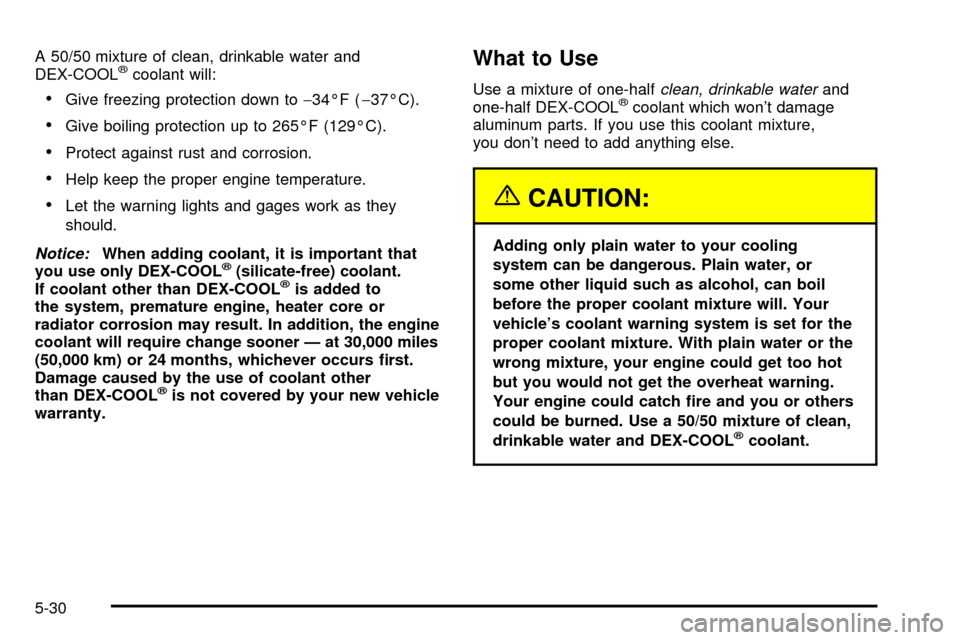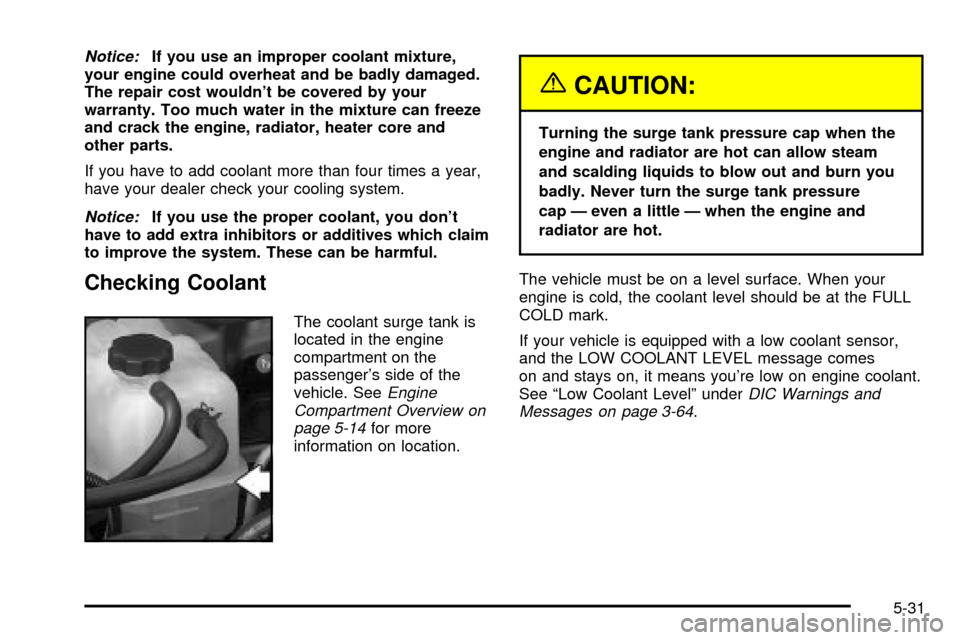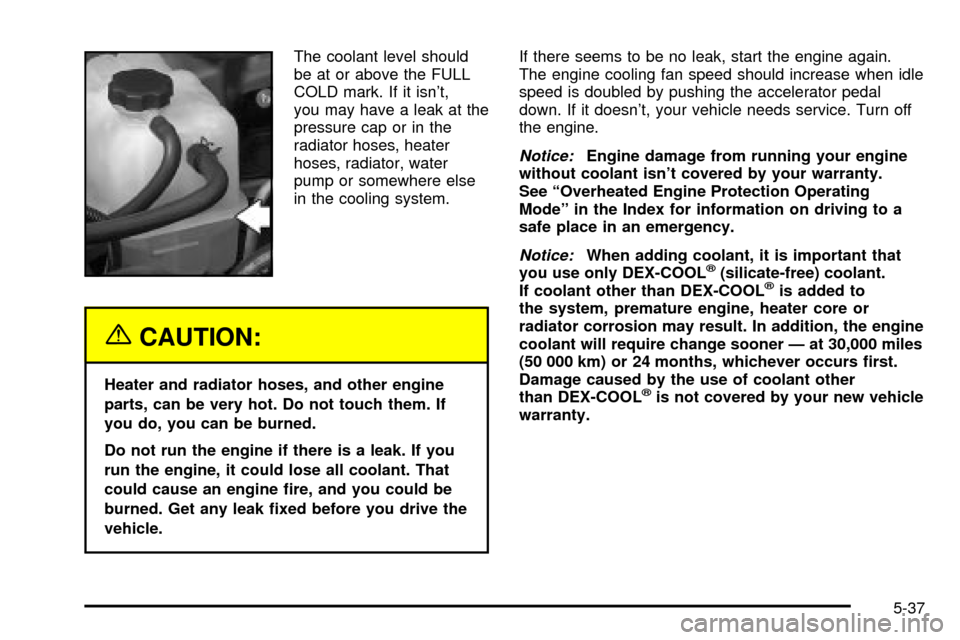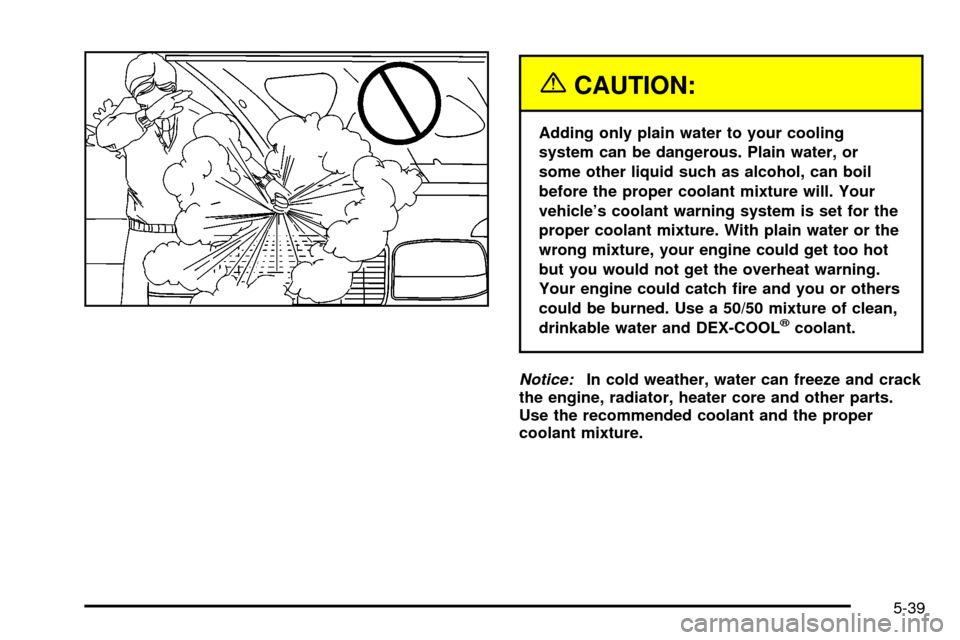2003 CHEVROLET SUBURBAN heater
[x] Cancel search: heaterPage 383 of 552

Some gasolines that are not reformulated for low
emissions may contain an octane-enhancing additive
called methylcyclopentadienyl manganese tricarbonyl
(MMT); ask the attendant where you buy gasoline
whether the fuel contains MMT. General Motors does
not recommend the use of such gasolines. Fuels
containing MMT can reduce the life of spark plugs and
the performance of the emission control system may
be affected. The malfunction indicator lamp may turn on.
If this occurs, return to your authorized GM dealer for
service.
Fuel E-85 (85% Ethanol)
The 8th digit of your vehicle identi®cation number (VIN)
shows the code letter or number that identi®es your
engine. You will ®nd the VIN at the top left of the
instrument panel. See
Vehicle Identi®cation Number
(VIN) on page 5-107.
If your vehicle has the 5.3L V8 engine (VIN Code Z
only), you may use either regular unleaded gasoline or
ethanol fuel containing up to 85% ethanol (E-85);
also see
Fuel on page 5-4. In all other engines, including
the 5.3L V8 (VIN Code T), use only regular unleaded
gasoline.Only vehicles that have the 5.3L V8 engine (VIN Code Z)
may use 85% ethanol fuel (E-85).
Many service stations will not have an 85% ethanol fuel
(E-85) pump available. The U. S. Department of
Energy has an alternative fuels website
(http://afdcmap.nrel.gov/nrel/) that can help you ®nd
E-85 fuel. Those stations that do have E-85 should have
a label indicating ethanol content. Do not use the fuel
if the ethanol content is
greaterthan 85%. Your vehicle
may not operate properly if the ethanol content is
greater than 85%.
At a minimum, E-85 should meet ASTM Speci®cation
D 5798.
To insure quick starts in the wintertime, the E-85 fuel
must be formulated properly for your climate according
to ASTM speci®cation D 5798. If you have trouble
starting on E-85, it may be because your E-85 fuel is
not properly formulated for your climate. If this happens,
switching to gasoline or adding gasoline to your fuel
tank may improve starting. Your vehicle is designed to
accommodate a mixture of gasoline and E-85 fuel.
For good starting and heater efficiency below 32ÉF
(0ÉC), the fuel mix in the fuel tank should contain no
more than 70% ethanol.
5-7
Page 406 of 552

A 50/50 mixture of clean, drinkable water and
DEX-COOLžcoolant will:
·Give freezing protection down to-34ÉF (-37ÉC).
·Give boiling protection up to 265ÉF (129ÉC).
·Protect against rust and corrosion.
·Help keep the proper engine temperature.
·Let the warning lights and gages work as they
should.
Notice:When adding coolant, it is important that
you use only DEX-COOLž(silicate-free) coolant.
If coolant other than DEX-COOLžis added to
the system, premature engine, heater core or
radiator corrosion may result. In addition, the engine
coolant will require change sooner Ð at 30,000 miles
(50,000 km) or 24 months, whichever occurs ®rst.
Damage caused by the use of coolant other
than DEX-COOL
žis not covered by your new vehicle
warranty.
What to Use
Use a mixture of one-halfclean, drinkable waterand
one-half DEX-COOLžcoolant which won't damage
aluminum parts. If you use this coolant mixture,
you don't need to add anything else.
{CAUTION:
Adding only plain water to your cooling
system can be dangerous. Plain water, or
some other liquid such as alcohol, can boil
before the proper coolant mixture will. Your
vehicle's coolant warning system is set for the
proper coolant mixture. With plain water or the
wrong mixture, your engine could get too hot
but you would not get the overheat warning.
Your engine could catch ®re and you or others
could be burned. Use a 50/50 mixture of clean,
drinkable water and DEX-COOL
žcoolant.
5-30
Page 407 of 552

Notice:If you use an improper coolant mixture,
your engine could overheat and be badly damaged.
The repair cost wouldn't be covered by your
warranty. Too much water in the mixture can freeze
and crack the engine, radiator, heater core and
other parts.
If you have to add coolant more than four times a year,
have your dealer check your cooling system.
Notice:If you use the proper coolant, you don't
have to add extra inhibitors or additives which claim
to improve the system. These can be harmful.
Checking Coolant
The coolant surge tank is
located in the engine
compartment on the
passenger's side of the
vehicle. See
Engine
Compartment Overview on
page 5-14
for more
information on location.
{CAUTION:
Turning the surge tank pressure cap when the
engine and radiator are hot can allow steam
and scalding liquids to blow out and burn you
badly. Never turn the surge tank pressure
cap Ð even a little Ð when the engine and
radiator are hot.
The vehicle must be on a level surface. When your
engine is cold, the coolant level should be at the FULL
COLD mark.
If your vehicle is equipped with a low coolant sensor,
and the LOW COOLANT LEVEL message comes
on and stays on, it means you're low on engine coolant.
See ªLow Coolant Levelº under
DIC Warnings and
Messages on page 3-64.
5-31
Page 411 of 552

If No Steam Is Coming From Your
Engine
An overheat warning, along with a low coolant condition,
can indicate a serious problem. SeeLow CoolantunderDIC Warnings and Messages on page 3-64.
If you get an engine overheat warning with and do not
have a low coolant condition, but see or hear no steam,
the problem may not be too serious. Sometimes the
engine can get a little too hot when you:
·Climb a long hill on a hot day.
·Stop after high-speed driving.
·Idle for long periods in traffic.
·Tow a trailer. SeeTowing a Trailer on page 4-65.
If you get the overheat warning with no sign of steam, try
this for a minute or so:
1. In heavy traffic, let the engine idle in neutral while
stopped. If it is safe to do so, pull off the road. Shift
to park or neutral and let the engine idle.
2. Turn on your heater to full hot at the highest fan
speed and open the window as necessary.If you no longer have the overheat warning, you can
drive. Just to be safe, drive slower for about 10 minutes.
If the warning doesn't come back on, you can drive
normally.
If the warning continues, pull over, stop, and park your
vehicle right away.
If there's still no sign of steam, you can push down the
accelerator until the engine speed is about twice as
fast as normal idle speed for at least three minutes while
you're parked. If you still have the warning,
turn off
the engine and get everyone out of the vehicleuntil it
cools down. Also, seeOverheated Engine Protection
Operating Modelisted previously in this section.
You may decide not to lift the hood but to get service
help right away.
5-35
Page 413 of 552

The coolant level should
be at or above the FULL
COLD mark. If it isn't,
you may have a leak at the
pressure cap or in the
radiator hoses, heater
hoses, radiator, water
pump or somewhere else
in the cooling system.
{CAUTION:
Heater and radiator hoses, and other engine
parts, can be very hot. Do not touch them. If
you do, you can be burned.
Do not run the engine if there is a leak. If you
run the engine, it could lose all coolant. That
could cause an engine ®re, and you could be
burned. Get any leak ®xed before you drive the
vehicle.If there seems to be no leak, start the engine again.
The engine cooling fan speed should increase when idle
speed is doubled by pushing the accelerator pedal
down. If it doesn't, your vehicle needs service. Turn off
the engine.
Notice:Engine damage from running your engine
without coolant isn't covered by your warranty.
See ªOverheated Engine Protection Operating
Modeº in the Index for information on driving to a
safe place in an emergency.
Notice:When adding coolant, it is important that
you use only DEX-COOLž(silicate-free) coolant.
If coolant other than DEX-COOLžis added to
the system, premature engine, heater core or
radiator corrosion may result. In addition, the engine
coolant will require change sooner Ð at 30,000 miles
(50 000 km) or 24 months, whichever occurs ®rst.
Damage caused by the use of coolant other
than DEX-COOL
žis not covered by your new vehicle
warranty.
5-37
Page 415 of 552

{CAUTION:
Adding only plain water to your cooling
system can be dangerous. Plain water, or
some other liquid such as alcohol, can boil
before the proper coolant mixture will. Your
vehicle's coolant warning system is set for the
proper coolant mixture. With plain water or the
wrong mixture, your engine could get too hot
but you would not get the overheat warning.
Your engine could catch ®re and you or others
could be burned. Use a 50/50 mixture of clean,
drinkable water and DEX-COOL
žcoolant.
Notice:In cold weather, water can freeze and crack
the engine, radiator, heater core and other parts.
Use the recommended coolant and the proper
coolant mixture.
5-39
Page 537 of 552

Coolant.........................................................3-45
Engine Temperature Gage............................3-45
Heater, Engine............................................2-24
Surge Tank Pressure Cap.............................5-32
Cooling System..............................................5-36
Cruise Control Light........................................3-51
Cruise Control................................................3-10
Cupholder(s)..................................................2-61
Current and Past Model Order Forms................7-12
Customer Assistance Information........................ 7-8
Courtesy Transportation.................................. 7-8
Customer Assistance for Text Telephone (TTY)
Users....................................................... 7-4
Customer Assistance Offices........................... 7-4
Customer Satisfaction Procedure..................... 7-2
GM Mobility Program for Persons with
Disabilities................................................ 7-6
Reporting Safety Defects to General Motors....7-10
Reporting Safety Defects to the Canadian
Government............................................7-10
Reporting Safety Defects to the United States
Government............................................7-10
Roadside Assistance Program......................... 7-6
Service Publications Ordering Information........7-11D
Daytime Running Lamps..................................3-15
Defensive Driving............................................. 4-2
Defogging and Defrosting.........................3-23, 3-29
Delayed Locking.............................................2-10
Dinghy Towing................................................4-60
Doing Your Own Service Work........................... 5-3
Dolly Towing..................................................4-61
Dome Lamps.................................................3-18
Door.............................................................2-10
Delayed Locking..........................................2-10
Locks.......................................................... 2-8
Power Door Locks......................................... 2-9
Programmable Automatic Door Locks.............2-10
Rear Door Security Locks.............................2-13
DRIVER DOOR AJAR.....................................3-66
Driver Information Center (DIC).........................3-53
DIC Operation and Displays..........................3-54
DIC Warnings and Messages........................3-64
Driver............................................................1-30
Position, Safety Belt.....................................1-30
Driving Across an Incline..................................4-36
Driving Downhill..............................................4-34
5
Page 538 of 552

Driving in Mud, Sand, Snow or Ice....................4-38
Driving in Water..............................................4-39
Driving On Grades..........................................4-75
Driving on Off-Road Hills.................................4-30
Driving on Snow or Ice....................................4-52
Driving Through Deep Standing Water...............4-44
Driving Through Flowing Water.........................4-44
Driving Uphill..................................................4-31
Driving with a Trailer.......................................4-73
Driving..........................................................4-40
At Night.....................................................4-40
City...........................................................4-45
Defensive..................................................... 4-2
Drunken....................................................... 4-2
Freeway.....................................................4-46
Hill and Mountain Roads..............................4-49
In Rain and on Wet Roads...........................4-42
Winter........................................................4-51
Dual Automatic Climate Control System.............3-25
Dual Climate Control System............................3-21
DVD Player..................................................3-114
DVD ............................................................3-129
Cleaning the Video Screen..........................3-129
Distortion..................................................3-126
Rear Seat Entertainment System..................3-114E
Easy Exit Seat...............................................2-67
Electrical System...........................................5-108
Add-On Equipment.....................................5-108
Fuses and Circuit Breakers.........................5-109
Power Windows and Other Power Options....5-108
Windshield Wiper Fuses.............................5-108
Electrochromic Mirror Operation................2-46, 2-49
Emissions Inspection and
Maintenance Programs.................................3-50
ENGINE COOLANT HOT.................................3-66
Engine Coolant Level Check.............................6-11
Engine Hour Meter Display...............................3-38
Engine Oil Additives........................................5-21
Engine Oil and Chassis Lubrication Scheduled
Maintenance................................................. 6-5
Engine Oil Level Check...................................6-11
ENGINE OVERHEATED..................................3-66
Engine..........................................................5-23
Air Cleaner/Filter.........................................5-23
Battery.......................................................5-48
Check and Service Engine Soon Light............3-47
Compartment Overview................................5-14
Coolant Heater............................................2-24
6